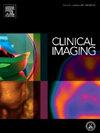A review of explainable AI techniques and their evaluation in mammography for breast cancer screening
IF 1.5
4区 医学
Q3 RADIOLOGY, NUCLEAR MEDICINE & MEDICAL IMAGING
引用次数: 0
Abstract
Explainable AI (XAI) methods are gaining prominence in medical imaging, addressing the critical need for transparency and trust in AI-driven diagnostic tools. Mammography, as the cornerstone of early breast cancer detection, holds immense potential for improving outcomes when integrated with AI solutions. However, widespread adoption of AI in clinical settings depends on explainability, which enhances clinicians' confidence in these tools. By exploring various XAI techniques and evaluating their strengths and weaknesses, researchers can significantly advance precision medicine. This review synthesizes existing research on XAI in medical imaging, focusing on mammography, a domain often overlooked in XAI studies. It provides a comparative analysis of XAI techniques employed in mammography, assessing their diagnostic efficacy and identifying research gaps, such as the lack of specialized evaluation frameworks. Additionally, the review examines evaluation methods for XAI in medical imaging and proposes modifications tailored to mammography diagnostics. Insights from XAI advancements in other fields are also explored for their potential to enhance interpretability and clinical relevance in breast cancer detection. The study concludes by highlighting critical research gaps and proposing directions for developing reliable, effective AI models that integrate XAI to transform breast cancer diagnostics.
可解释的人工智能技术及其在乳腺癌筛查乳房x光检查中的评估综述
可解释的人工智能(XAI)方法在医学成像领域日益突出,解决了对人工智能驱动的诊断工具的透明度和信任的关键需求。乳房x光检查作为早期乳腺癌检测的基石,与人工智能解决方案相结合,具有改善结果的巨大潜力。然而,人工智能在临床环境中的广泛采用取决于可解释性,这增强了临床医生对这些工具的信心。通过探索各种XAI技术并评估其优缺点,研究人员可以显著推进精准医学。本文综述了XAI在医学影像学中的现有研究,重点是乳房x线摄影,这是XAI研究中经常被忽视的领域。它提供了用于乳房x线照相术的XAI技术的比较分析,评估其诊断效果并确定研究差距,例如缺乏专门的评估框架。此外,本综述探讨了医学成像中XAI的评估方法,并提出了针对乳房x线摄影诊断的修改建议。XAI在其他领域的进展也将探讨其在乳腺癌检测中的可解释性和临床相关性方面的潜力。该研究最后强调了关键的研究差距,并提出了开发可靠、有效的人工智能模型的方向,这些模型将集成XAI来改变乳腺癌诊断。
本文章由计算机程序翻译,如有差异,请以英文原文为准。
求助全文
约1分钟内获得全文
求助全文
来源期刊

Clinical Imaging
医学-核医学
CiteScore
4.60
自引率
0.00%
发文量
265
审稿时长
35 days
期刊介绍:
The mission of Clinical Imaging is to publish, in a timely manner, the very best radiology research from the United States and around the world with special attention to the impact of medical imaging on patient care. The journal''s publications cover all imaging modalities, radiology issues related to patients, policy and practice improvements, and clinically-oriented imaging physics and informatics. The journal is a valuable resource for practicing radiologists, radiologists-in-training and other clinicians with an interest in imaging. Papers are carefully peer-reviewed and selected by our experienced subject editors who are leading experts spanning the range of imaging sub-specialties, which include:
-Body Imaging-
Breast Imaging-
Cardiothoracic Imaging-
Imaging Physics and Informatics-
Molecular Imaging and Nuclear Medicine-
Musculoskeletal and Emergency Imaging-
Neuroradiology-
Practice, Policy & Education-
Pediatric Imaging-
Vascular and Interventional Radiology
 求助内容:
求助内容: 应助结果提醒方式:
应助结果提醒方式:


